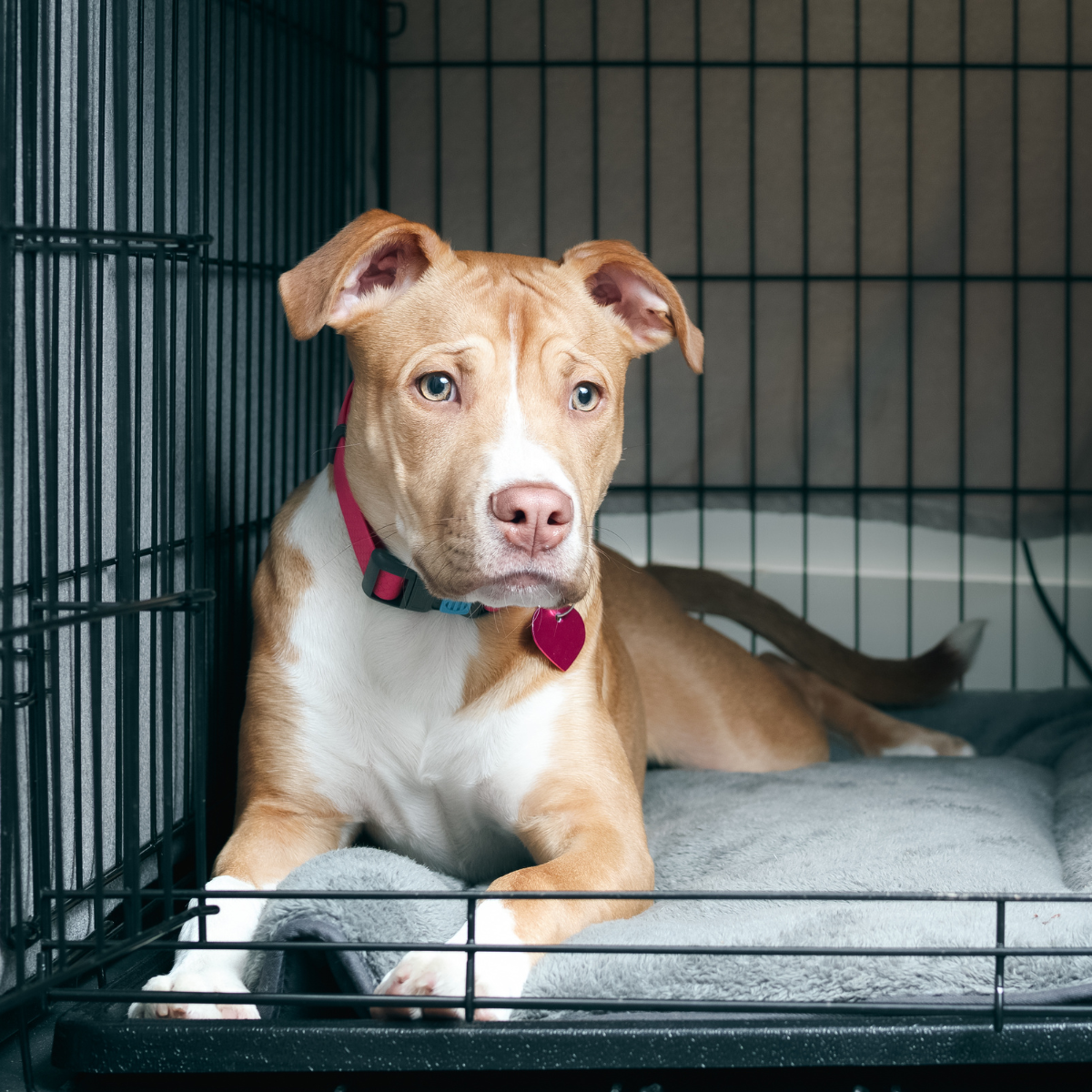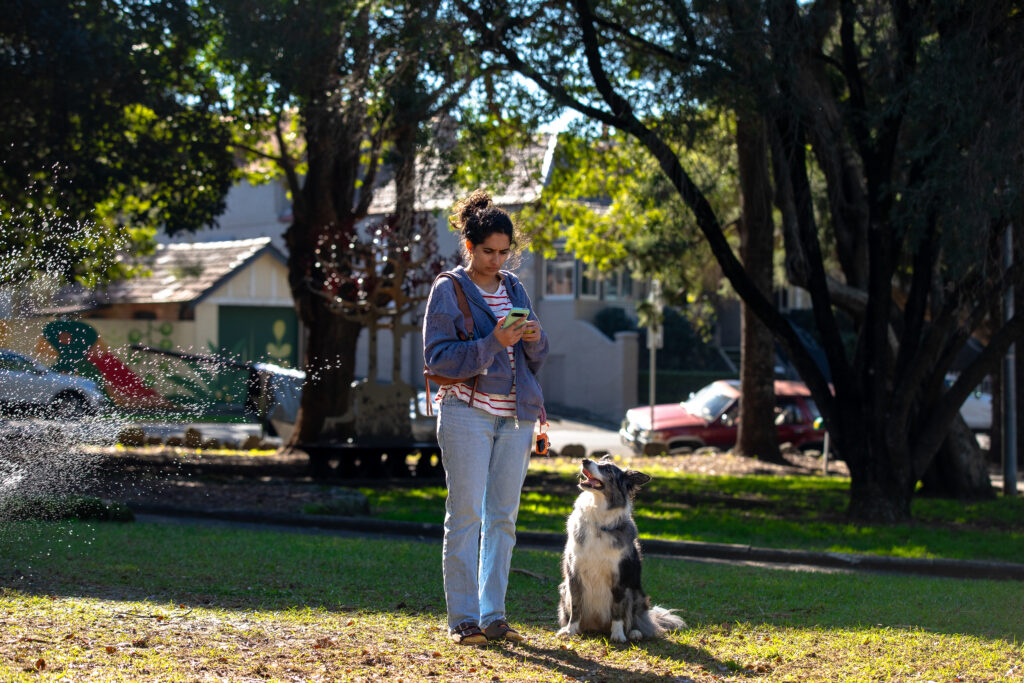Crate training teaches your dog or puppy to feel safe and comfortable in a crate: a small, enclosed space that acts like their own little bedroom. The goal is for your dog to see the crate as a secure spot where they can rest, relax, or take a break from the world.
Crates can benefit both dogs and their owners. For dogs, they offer a quiet place to feel calm and protected. For owners, crates are helpful for managing behaviour, especially during toilet training or when you’re not home. Crate training can also reduce destructive habits, like chewing on furniture, by keeping your dog safely contained when unsupervised.
Why Crate Training is Beneficial
Safe Space
A crate gives your dog a safe space to rest when you’re not home or can’t supervise them. It helps prevent accidents or destructive behaviours like chewing furniture or getting into dangerous items.
Toilet Training
Since dogs naturally avoid toileting where they sleep, crates are a great tool for teaching them to hold it until they’re let outside, making house training easier and faster.
Easier Travel
A crate-trained dog is more relaxed and secure when traveling – whether it’s in a car, on a plane, or staying in a hotel.
Rest & Recovery
If your dog is recovering from surgery, illness, or injury, a crate is an effective way to limit movement and keep them safe during healing.
A Personal Retreat
Over time, many dogs come to love their crate and use it as their own cozy retreat; a quiet place to nap, chew a toy, or just unwind.
Set Yourself and your Pooch up for Success
Choose the Right Size
The crate should be just big enough for your dog to stand up, turn around, and lie down comfortably. If it’s too large, especially during toilet training, your dog might use one end as a toilet and sleep in the other. Crates should feel snug, cozy, and secure – not like an open room. If you have a puppy, you may need to upgrade the crate size as they grow.
Make It Comfortable
Add a soft bed or blanket inside, along with your dog’s favourite toys, treats, or long-lasting chews. Nervous dogs may benefit from a calming spray like Adaptil or a light spritz of lavender on the bedding.
Important: Keep the area around the crate clear of anything your dog could pull inside, like cords, curtains, rugs, or small objects.
Pick the Right Spot
Where you place the crate depends on your training goals:
- For overnight sleep, put it in your bedroom so your dog still feels close to you.
- For daytime relaxation, place one in a common area like the lounge room or living space.
Avoid high-traffic or noisy areas, especially if your dog is easily overstimulated by people, pets, or street activity. This could make crate training more stressful and less effective.
Make It Den-Like
Cover the top, back, and sides of the crate with a blanket or sheet. This helps your dog feel secure by limiting visual distractions, making the crate feel like a calm, enclosed den.
Always Keep It Positive
The crate should be a safe and happy place, never a punishment. Don’t force your dog into the crate. With the right approach, they’ll learn to enter it willingly and enjoy their time inside.
Start Training
- Introduce the Crate
Place the crate somewhere your dog can explore comfortably. Leave the door open and encourage them to check it out using treats, toys, and gentle praise. You can also feed them meals near (or inside) the crate to build a positive association. Let them go in and out freely without pressure. - Build Up to Longer Stays
Once your dog is comfortable entering the crate, begin gently closing the door for short periods while they’re inside. Start with just 30 seconds, then slowly increase the time. Stay nearby and offer a chew toy or treat to keep them occupied. Use a timer if helpful to stay consistent.
Tip for sensitive dogs: Practice opening and closing the door while your dog is calmly sitting or lying inside, so they get used to the motion without becoming anxious.
- Watch for Signs of Stress
Some dogs may whine, bark, or paw at the crate when the door is closed. Mild frustration can be ignored, but if your dog becomes frantic, you’ve moved too quickly. Wait until they settle, then calmly let them out. Avoid opening the door while they’re in a heightened state, this can accidentally reinforce the behaviour. - Practise Leaving the Room
Once your dog is comfortable being in the crate with the door closed, try leaving the room for a few minutes. Gradually increase the time as they remain calm. When you return, keep your greeting low-key and relaxed – this teaches your dog that your comings and goings are no big deal. - Practise Leaving the House
After your dog can relax in the crate (lying down, chewing, or sleeping), start leaving the house for short periods. Begin with just a few minutes and slowly work up to longer absences. Adult dogs can safely stay in crates for up to 9–10 hours overnight. - Create a Calm Sleep Environment
At night, covering the crate fully with a light blanket or sheet helps create a cozy, den-like space. This encourages your dog to settle down, relax, and sleep soundly.
Important Tips
Avoid Punishment
Never use the crate as a form of punishment. It should be a positive space for your dog.
Patience is Key
Progress at your dog’s pace. Some dogs may take longer to adjust.
Consistency
Establish a routine to help your dog feel secure and understand expectations.
Exercise Before Crating
Ensure your dog has had sufficient exercise before crating to reduce restlessness.
Comfy Space
Try NOT to force the dog into the crate, this will lead to a negative association with the crate, and it will get increasingly harder to get the dog into the crate. Place the crate in your dog’s safe space and make it your dogs “comfy space”. Place lots of blankets and toys inside, so that your dog chooses to enter the crate to relax.
Busting Out of the Crate
Don’t get angry and don’t punish the dog. It’s too late and the dog will not understand why you are so mad. Busting out of the crate is a sure sign that the dog is not yet crate trained. Try the above tip about making the crate your dogs “comfy space”. If issues still persist, consider speaking to your vet.
Separation Anxiety
Attempting to use the crate to fix separation anxiety won’t solve the problem. A crate may prevent your dog from being destructive, but they may injure themselves in an attempt to escape from the crate. If you believe your dog has separation anxiety, please consult a vet.
Crate training is about creating a safe and comfortable environment for your dog. With patience, consistency, and care, your dog can learn to see their crate as a cozy and secure retreat.



